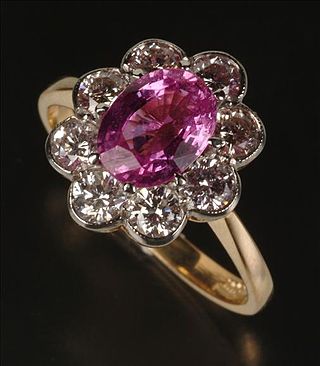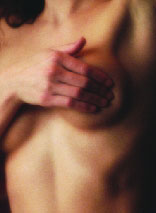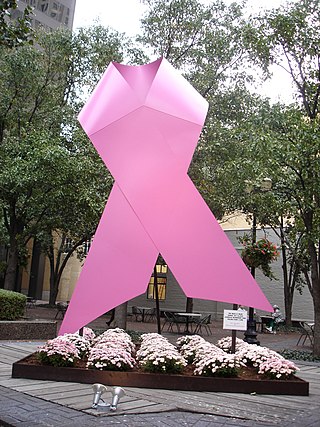
Breast cancer is a cancer that develops from breast tissue. Signs of breast cancer may include a lump in the breast, a change in breast shape, dimpling of the skin, milk rejection, fluid coming from the nipple, a newly inverted nipple, or a red or scaly patch of skin. In those with distant spread of the disease, there may be bone pain, swollen lymph nodes, shortness of breath, or yellow skin.

Pink is the color of a namesake flower that is a pale tint of red. It was first used as a color name in the late 17th century. According to surveys in Europe and the United States, pink is the color most often associated with charm, politeness, sensitivity, tenderness, sweetness, childhood, femininity, and romance. A combination of pink and white is associated with innocence, whereas a combination of pink and black links to eroticism and seduction. In the 21st century, pink is seen as a symbol of femininity, though this has not always been true; in the 1920s, pink was seen as a color that reflected masculinity.

Breast self-examination (BSE) is a screening method used in an attempt to detect early breast cancer. The method involves the woman herself looking at and feeling each breast for possible lumps, distortions or swelling.

Susan G. Komen is a breast cancer organization in the United States.

Breast Cancer Action (BCAction) is a U.S.-based grassroots education and activist organization driven by and supporting people living with breast cancer. It was founded in 1990 by Elenore Pred, Susan Claymon, Belle Shayer, and Linda Reyes. Based in San Francisco, BCAction is known for understanding breast cancer not as an individual crisis, but a public health emergency, and for their commitment to social justice. The organization's mission is to achieve health justice for all women at risk of and living with breast cancer. BCAction is known for its Think Before You Pink campaign, launched in 2002, which encourages consumers to ask critical questions before buying pink ribbon products and holds corporations accountable for pinkwashing.
Cause marketing is marketing done by a for-profit business that seeks to both increase profits and to better society in accordance with corporate social responsibility, such as by including activist messages in advertising.

Breast Cancer Awareness Month (BCAM), also referred to in the United States as National Breast Cancer Awareness Month (NBCAM), is an annual international health campaign organized by major breast cancer charities every October to increase awareness of the disease and raise funds for research into its cause, prevention, diagnosis, treatment, and cure.

The Baltimore Nighthawks are a women's American football team in the Women's Football Alliance. The Nighthawks played their inaugural game in Brooklandville at Martin D. Tullai Field. The Nighthawks played the remainder of their home season at the Baltimore Lutheran School in Towson.
Evelyn Lauder was an Austrian American businesswoman, socialite and philanthropist who has been credited as one of the creators and popularizers of the pink ribbon as a symbol for awareness of breast cancer.

Global Pink Hijab Day was an initiative that began as an experiment by founder, Hend El-Buri and a group of high school students in Columbia, Missouri. It was intended to remove stereotypes of Muslim women by having Muslims engage in dialogue about breast cancer awareness, joining walks in groups while wearing pink headscarves, and holding other events promoting awareness and support for the cause. Global Pink Hijab Day was last celebrated in 2011.

Team Heather is a fundraising group in the Susan G. Komen for the Cure Global Race for the Cure in Washington, D.C., which has raised over $403,000, since June, 2001, for Susan G. Komen for the Cure and breast cancer research, education, screening, and treatment. Team Heather was formed in 2001 to support 25-year-old Heather Gardner (Starcher) (1976–2002), as she began her fight against breast cancer – a fight that ended on September 29, 2002.
Pinkwashing is a portmanteau word which combines "pink" and "whitewashing". The term is most often used to describe various forms of cause marketing.

Breast cancer awareness is an effort to raise awareness and reduce the stigma of breast cancer through education about screening, symptoms, and treatment. Supporters hope that greater knowledge will lead to earlier detection of breast cancer, which is associated with higher long-term survival rates, and that money raised for breast cancer will produce a reliable, permanent cure.

Pink Ribbons, Inc. is a 2011 National Film Board of Canada (NFB) documentary about the pink ribbon campaign, directed by Léa Pool and produced by Ravida Din. The film is based on the 2006 book Pink Ribbons, Inc: Breast Cancer and the Politics of Philanthropy by Samantha King, associate professor of kinesiology and health studies at Queen's University.

Ravida Din is a Canadian film producer who formerly served with the National Film Board of Canada (NFB) as a producer, executive producer, then as its Director General of English-language production, from February 11, 2013, to February 26, 2014.

Pinkwashing is a form of cause marketing that uses a pink ribbon logos. The companies display the pink ribbon logo on products that are known to cause different types of cancer. The Pink ribbon logo symbolizes support for breast cancer-related charities or foundations.

Wacoal is a manufacturer of women's lingerie and underwear, founded in 1949 in Japan by Koichi Tsukamoto. The company has divisions in North America and Europe, and manufactures the brands Wacoal, b.tempt'd, Elomi, Eveden, Fantasie, Freya, Lively, and Goddess.

No Bra Day is an annual observance on October 13 on which women are encouraged to go braless as a means to encourage breast cancer awareness. No Bra Day was initially observed on July 9, 2011, but within three years it had moved to the 13th day of the National Breast Cancer Awareness Month, October. Users on social media are encouraged to post using the hashtag #nobraday to promote awareness of breast cancer symptoms and to encourage gender equality. Some users on social media sites also encourage women to post pictures of themselves not wearing a bra. Some women embrace No Bra Day as a political statement while others prefer the comfort of discarding what they view as a restrictive, uncomfortable garment.

The colors pink and blue are associated with girls and boys respectively, in the United States, the United Kingdom and some other European countries.


















